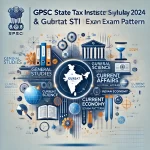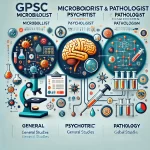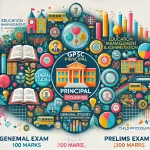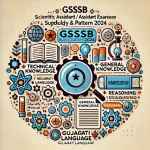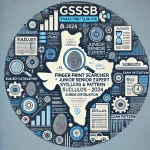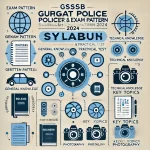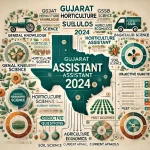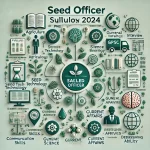Gujarat Public Service Commission (GPSC) conducts Assistant Engineer (Mechanical) examination on 34 vacancies for recruitment in Narmada Water Resources and Water Supply Department. This AE exam is highly competitive and aims to assess the candidate’s technical knowledge and general abilities required for a career in this public sector.
Contents
- 1 GPSC Assistant Engineer (Mechanical) Exam Pattern 2024
- 2 Important Links
- 3 Gujarat AE Preliminary Written Examination:
- 4 GPSC Narmada Water AE General Studies Syllabus (100 Marks)
- 5 Mechanical Engineering (200 Marks)
- 6 Interview: GPSC Assistant Engineer (Mechanical) [Narmada Water Supply]
- 7 Important FAQS
GPSC Assistant Engineer (Mechanical) Exam Pattern 2024
Understanding the examination pattern and syllabus is crucial for effective preparation. Here’s a detailed guide to the GPSC Assistant Engineer (Mechanical) exam syllabus and pattern for the Narmada Water Resources & Water Supply Department.
![GPSC Assistant Engineer (Mechanical) Syllabus 2024 & Exam Pattern [Narmada Water Supply]](https://4syllabus.in/wp-content/uploads/2024/09/GPSC-Assistant-Engineer-Mechanical-Syllabus-2024-Exam-Pattern-Narmada-Water-Supply.webp)
The GPSC Assistant Engineer (Mechanical) examination consists of two main stages: Preliminary Written Examination + Interview
| Recruitment Conducted By | Gujarat Public Service Commission (GPSC) |
| Name of Exam | Assistant Engineer (Mechanical), Class-2 Narmada Water Resources, Water Supply & Kalpsar Department |
| No of Vacancies | 34 Posts |
| Category | Syllabus & Pattern |
| Advt No. | 36/2024-25 |
| Salary | INR 44,900 -1,42,400 Pay Matrix Level-8 (ROP-2016) |
| Expected Exam Date | 01 Jan 2025 |
| Selection | Preliminary Exam & Interview |
| Official Website | gpsc.gujarat.gov.in |
Important Links
- Must See: GPSC State Tax Inspector Syllabus 2024 & Gujarat STI Exam Pattern
- For Latest GPSC Updates:- https://4syllabus.in/tag/gpsc
- Latest GSSSB Updates:- https://4syllabus.in/tag/gsssb
- For Latest Government Jobs in Gujarat:- https://4syllabus.in/tag/gujarat/
- Official GPSC Website:- https://gpsc.gujarat.gov.in
Gujarat AE Preliminary Written Examination:
- Type of Exam: Objective (Multiple Choice Questions)
- Part-1: General Studies (Medium: Gujarati)
- Part-2: Technical Paper (Mechanical Engineering) (Medium: English)
- Duration: 3 hours
- Total Marks: 300 marks
- Subjects: General Studies: 100 marks, Mechanical Engineering (Technical Subject): 200 marks
- Negative Marking: 0.3 Marks for each wrong answer.
| Paper | Subject | Marks |
| Preliminary Exam | General Studies (Part-1) | 100 |
| Engineering Subject (Part-2) | 200 | |
| PRELIMS TOTAL | 300 | |
| Interview | 100 |
GPSC Narmada Water AE General Studies Syllabus (100 Marks)
The General Studies section focuses on evaluating a candidate’s knowledge about current events, history, general science, Indian politics, and more. The topics include:
- Geography of India:- Physical, Economic, Social, Natural Resources and population related
topics- with special reference to Gujarat - Cultural heritage of India:- Literature, Art, Religion and Architecture- with special reference
to Gujarat - History of India with special reference to Gujarat
- Indian Economy and Planning
- Indian Polity and the Constitution of India:-
- Preamble
- Fundamental Rights and Fundamental Duties
- Directive Principles of State Policy
- Composition of Parliament
- Powers of the President of India
- Powers of Governor
- Judiciary
- Provisions for Scheduled Castes, Scheduled Tribes and backward classes of the society
- Attorney General
- NITI Aayog
- Panchayati Raj Institutions
- Finance Commission
- Constitutional and Statutory Bodies:- Election Commission of India, Union Public Service Commission, State Public Service Commission, Comptroller and Auditor General; Central Vigilance Commission, Lokpal and Lokayukta, Central Information Commission
- General Mental Ability
- General Science, Environment and Information & Communication Technology
- Daily events of Regional, National and International Importance including Sports
Mechanical Engineering (200 Marks)
This section will evaluate the candidate’s core mechanical engineering knowledge. The topics are as per the syllabus followed in undergraduate mechanical engineering courses. Key subjects include:
- THERMODYNAMICS: Fundamentals- thermodynamic systems and control Volume; Thermodynamic Properties, Process and state; Exact and Inexact differentials; Work-Thermodynamic definition; Temperature, Definition of thermal equilibrium and Zeroth law; Definition of heat; Definition of Pure substance, Ideal Gases and ideal gas mixtures, Real gases and real gas mixtures, Properties of pure substances, behavior of ideal and real gases; Definitions of saturated states; Identification of states & determination of properties, Mollier’s chart. First Law for Cyclic & Non-cyclic processes; Concept of total energy E; Various modes of energy, Internal energy and Enthalpy.
- Second law – Definitions of direct and reverse heat engines; Definitions of thermal efficiency and COP; Kelvin-Planck and Clausius statements; Definition of reversible process; Internal and external irreversibility; Carnot cycle; Absolute temperature scale. Clausius inequality; Definition of entropy S ; Evaluation of S for solids, liquids, ideal gases and ideal gas mixtures undergoing various processes; Principle of increase of entropy; Definition of Isentropic efficiency for compressors, turbines and nozzles- Irreversibility and Availability, Availability function for systems and Control volumes undergoing different processes, Lost work. Second law analysis for a control volume. Exergy balance equation and Exergy analysis.
- Thermodynamic cycles – Basic Rankine cycle; Basic Brayton cycle; Basic vapor compression cycle and comparison with Carnot cycle.
- HEAT-TRANSFER: Introduction to three modes of heat transfer, heat balance equation- Steady one dimensional solution for conduction heat transfer, concept of conduction and film resistances, critical insulation thickness, lumped system approximation and Biot number, heat transfer through pin fins- Two dimensional conduction solutions for both steady and unsteady heat transfer, Heissler charts.
- Heat convection, basic equations, boundary layers- Forced convection, external and internal flows- Natural convective heat transfer- Dimensionless parameters for forced and free convection heat transfer-Correlations for forced and free convection- Approximate solutions to laminar boundary layer equations (momentum and energy) for both internal and external flow- Estimating heat transfer rates in laminar and turbulent flow situations using appropriate correlations for free and forced convection.
- Interaction of radiation with materials, definitions of radiative properties, Stefan Boltzmann’s law, black and gray body radiation, Wien’s displacement law
- Types of heat exchangers, Analysis and design of heat exchangers using both LMTD and NTU methods,
- Introduction mass transfer, Similarity between heat and mass transfer.
- Mathematics: Multivariable Calculus (Integration), Multiple Integration, Double integrals (Cartesian), change of order of integration in double integrals, Change of variables (Cartesian to polar), Applications: areas and volumes, Center of mass and Gravity (constant and variable densities); Triple integrals (Cartesian), orthogonal curvilinear coordinates, Simple applications involving cubes, sphere and rectangular parallelepipeds; Scalar line integrals, vector line integrals, scalar surface integrals, vector surface integrals, Theorems of Green, Gauss and Stokes.
- First order ordinary differential equations: Exact, linear and Bernoulli’s equations, Euler’s equations, Equations not of first degree: equations solvable for p, equations solvable for y, equations solvable for x and Clairaut’s type.
- Ordinary differential equations of higher orders: Second order linear differential equations with variable coefficients, method of variation of parameters, Cauchy-Euler equation; Power series solutions; Legendre polynomials, Bessel functions of the first kind and their properties.
- Complex Variable – Differentiation: Differentiation, Cauchy-Riemann equations, analytic functions, harmonic functions, finding harmonic conjugate; elementary analytic functions (exponential, trigonometric, logarithm) and their properties; Conformal mappings, Mobius transformations and their properties.
- Complex Variable – Integration: Contour integrals, Cauchy-Goursat theorem (without proof), Cauchy Integral formula (without proof), Liouville’s theorem and Maximum- Modulus theorem (without proof); Taylor’s series, zeros of analytic functions, singularities, Laurent’s series; Residues, Cauchy Residue theorem (without proof), Evaluation of definite integral involving sine and cosine, Evaluation of certain improper integrals using the Bromwich contour.
- Fluid Mechanics: Definition of fluid, Newton’s law of viscosity, Units and dimensions-Properties of fluids, mass density, specific volume, specific gravity, viscosity, compressibility and surface tension, manometry, buoyancy, forces on submerged bodies, stability of floating bodies, fluid acceleration, fluid statics, momentum and energy, Control volume- application of continuity equation and momentum equation, Incompressible flow, Bernoulli’s equation and its applications.
- Exact flow solutions in channels and ducts, Couette and Poisuielle flow, laminar flow through circular conduits and circular annuli- concept of boundary layer – measures of boundary layer thickness – Darcy Weisbach equation, friction factor, Moody’s diagram. Elementary turbulent flow, flow through pipes, head losses in pipes, bends and fittings, Types of Pipes.
- Need for dimensional analysis–methods of dimension analysis–Similitude–types of similitude
- Dimensionless parameters–application of dimensionless parameters–Model analysis.
- Euler’s equation – theory of Rotodynamic machines – various efficiencies – velocity components at entry and exit of the rotor, velocity triangles – Centrifugal pumps, working principle, work done by the impeller, performance curves – Cavitation in pumps- Reciprocating pump–working principle.
- Classification of water turbines, heads and efficiencies, velocity triangles- Axial, radial and mixed flow turbines- Pelton wheel, Francis turbine and Kaplan turbines, working principles – draft tube-Specific speed, unit quantities, performance curves for turbines – governing of turbines. Types of Pumps, Pump viscosity, Centrifugal, NPSH, Pump curves, Progressive cavity, Screw pumps, Rope Pump, Submersible, Vertical turbine, Coupling section, Motor section, Well Section,
- Hydraulic Principles, General pumping fundamental. Spillways-Types of spillway based on most prominent features, Spillway Crest Gates. Flood Management: Methods of Flood Control, Flood Alleviation or Flood Mitigation, Structural Mitigation Measures, Non-Structural Mitigation Measures.
- Power Engineering and Power Plant Engineering: Air and gas compressors; vapor and gas power cycles, concepts of regeneration and reheat. Coal based thermal power plants, basic Rankine cycle and its modifications, layout of modern coal power plant, super critical boilers, FBC boilers, turbines, condensers, steam and heating rates, subsystems of thermal power plants, fuel and ash handling, draught system, feed water treatment, binary cycles and cogeneration systems.
- Gas turbine and combined cycle power plants, Brayton cycle analysis and optimisation, components of gas turbine power plants, combined cycle power plants, Integrated Gasifier based Combined Cycle (IGCC) systems.
- Basics of nuclear energy conversion, Layout and subsystems of nuclear power plants, Boiling Water Reactor (BWR), Pressurised Water Reactor (PWR), CANDU Reactor, Pressurised Heavy Water Reactor (PHWR), Fast Breeder Reactors (FBR), gas cooled and liquid metal cooled reactors, safety measures for nuclear power plants.
- Hydroelectric power plants, classification, typical layout and components, principles of wind, tidal, solar PV and solar thermal, geothermal, biogas and fuel cell power systems Energy, economic and environmental issues, power tariffs, load distribution parameters, load curve, capital and operating cost of different power plants, pollution control technologies including waste disposal options for coal and nuclear plants.
- I.C. Engines: Combustion in SI and CI engines, Combustion stages, Combustion chambers and abnormal combustion. Fuel supply systems in SI and CI engines, carburetors, Port fuel injection, direct injection and Common rail injection. Ignition system, Lubrication system and Cooling system. Testing of IC engines. Engine emissions and control. Advanced IC Engine concepts Air-standard Otto, Diesel and dual cycles.
- Engine Management, Engine System, Engine Mapping, Open Loop Engine Control Systems, Closed loop Engine Control System, Additional Engine Management System, lean burn engine control. Complete Vehicle Control System, Artificial intelligence and Engine management. Maintenance and fault diagnostics of engine management system, Engine diagnostics, Troubles and Tune-up, Engine service.
- Vehicle performance- performance parameters. Heavy Earth Movers, Types of Excavators, Dumpers, Draggers, Cranes
- Refrigeration and air-conditioning: Vapour and gas refrigeration and heat pump cycles; properties of moist air, psychrometric chart, basic psychrometric processes.
- Strength of Materials: Deformation in solids- Hooke’s law, stress and strain- tension, compression and shear stresses-elastic constants and their relations- volumetric, linear and shear strains- principal stresses and principal planes- Mohr’s circle, Poisson’s Ratio.
- Beams and types transverse loading on beams- shear force and bend moment diagrams- Types of beam supports, simply supported and over- hanging beams, cantilevers. Theory of bending of beams, bending stress distribution and neutral axis, shear stress distribution, point and distributed loads. Moment of inertia about an axis and polar moment of inertia, deflection of a beam using double integration method, computation of slopes and deflection in beams, Maxwell’s reciprocal theorems.
- Torsion, stresses and deformation in circular and hollow shafts, stepped shafts, deflection of shafts fixed at both ends, stresses and deflection of helical springs. Axial and hoop stresses in cylinders subjected to internal pressure, deformation of thick and thin cylinders, deformation in spherical shells subjected to internal pressure. Euler’s Theory of columns, Energy methods, Thermal Stress, Strain Gauge and rosettes, Testing of Materials with Universal testing Machine, Testing of Hardness and Impact Strength.
- Engineering Mechanics: Free-body diagrams and equilibrium; trusses and frames; virtual work; kinematics and dynamics of particles and of rigid bodies in plane motion; impulse and momentum (linear and angular) and energy formulations, collisions.
- Kinematics and Theory of Machines: Classification of mechanisms-Basic kinematic concepts and definitions-Degree of freedom, mobility- Grashof’s law, Universal Joint-Rocker mechanisms Displacement, velocity and acceleration analysis of plane mechanisms; dynamic analysis of linkages; cams; gears and gear trains; flywheels and governors; balancing of reciprocating and rotating masses; gyroscope. Pumps and Motors, Compressors.
- Engineering Materials: Structure and properties of engineering materials, phase diagrams, heat treatment, stress- strain diagrams for engineering materials. Young’s modulus, generalized Hooke’s law, yielding and yield strength, ductility, resilience, toughness and elastic recovery; Hardness: Rockwell, Brinell and Vickers and their relation to strength.
- Static failure theories: Ductile and brittle failure mechanisms, Maximum normal stress, Mohr-Coulomb and Modified Mohr-Coulomb; Fracture mechanics: Introduction to Stress- intensity factor approach and Griffith criterion. Fatigue failure: High cycle fatigue, Stress-life approach, SN curve, endurance and fatigue limits, effects of mean stress using the Modified Goodman diagram; Introduction to non-destructive testing (NDT).
- Manufacturing Processes: Different types of castings, design of patterns, moulds and cores; solidification and cooling; riser and gating design. Plastic deformation and yield criteria; fundamentals of hot and cold working processes; load estimation for bulk (forging, rolling, extrusion, drawing) and sheet (shearing, deep drawing, bending) metal forming processes; principles of powder metallurgy.
- Principles of welding, brazing, soldering and adhesive bonding, Welding and weld Testing, Classifying Welding process, Fusion versus non-fusion, Pressure versus non- pressure, Energy source of welding, other basis for classification and sub-classification. Heat treatment process-Annealing, tempering, normalizing and spheroidising,
- Alloying of steel, properties of stainless steel and tool steels, maraging steels- cast irons; grey, white, malleable and spheroidal cast irons- copper and copper alloys; brass, bronze and cupro-nickel; Aluminum and Al-Cu – Mg alloys- Nickel based super alloys and Titanium alloys.
- Unconventional Machining Processes: Abrasive Jet Machining, Water Jet Machining, Abrasive Water Jet Machining, Ultrasonic Machining, principles and process parameters (5)Electrical Discharge Machining, principle and processes parameters, MRR, surface finish, tool wear, dielectric, power and control circuits, wire EDM; Electro-chemical machining (ECM), etchant & maskant, process parameters, MRR and surface finish. Laser Beam Machining (LBM), Plasma Arc Machining (PAM) and Electron Beam Machining. Metrology and
- Inspection: Limits, fits and tolerances; linear and angular measurements; comparators; gauge design; interferometry; form and finish measurement; alignment and testing methods; tolerance analysis in manufacturing and assembly.
- Computer Integrated Manufacturing: Basic concepts of CAD/CAM and their integration tools. NC/CNC Technology and Part programming, Microprocessors in Automation.
Basic Electronic Engineering - Semiconductor Devices and Applications: Introduction to P-N junction Diode and V-I characteristics, Half wave and Full-wave rectifiers, capacitor filter. Zener diode and its characteristics, Zener diode as voltage regulator. Regulated power supply IC based on 78XX and 79XX series, Introduction to BJT, it’s input-output and transfer characteristics, BJT as a single stage CE amplifier, frequency response and bandwidth.
- Operations Research: Linear programming, simplex method, transportation, assignment, network flow models, simple queuing models, PERT and CPM
- Current Trends and Recent Advancements in the field of Mechanical Engineering
Note: Syllabus for Assistant Engineer (Mechanical) has not yet announced officially by GPSC. Syllabus given here is based on previous exam conducted for the same post by same or other commissions. Once released officially on their official website, it will be updated here. It should be taken as reference syllabus only.
Interview: GPSC Assistant Engineer (Mechanical) [Narmada Water Supply]
- Marks: 100 marks
- Purpose: The interview round tests the candidate’s personality, communication skills, problem-solving abilities, and overall suitability for the role. Candidates who pass the written examination are called for the interview. Some examples are given below:-
- Can you explain the working principle of a centrifugal pump and its application in water resource management? Objective: To assess your knowledge of hydraulic machinery, especially pumps, which are critical in water distribution systems.
- What are the various types of water turbines, and how would you choose the most suitable one for a hydroelectric project in Gujarat? Objective: To evaluate your understanding of turbines and their application in hydro projects, especially in the context of Narmada Water Resources.
- How would you handle the challenge of corrosion in pipelines used for water supply? What materials or preventive measures would you recommend Objective: To test your awareness of material science, corrosion control, and its importance in maintaining the integrity of water supply infrastructure.Describe the steps involved in the design and maintenance of a water distribution system for a large urban area? Objective: To see how well you understand the principles of mechanical design, distribution systems, and the importance of regular maintenance for efficiency.
- How do you approach energy efficiency in pumping systems, and what measures can be implemented to reduce energy consumption in large-scale water supply operations? Objective: To assess your knowledge of energy management and optimization in mechanical systems, crucial for cost-effective water supply management.
The GPSC Assistant Engineer (Mechanical) examination for the Narmada Water Resources & Water Supply Department is designed to assess both general knowledge and technical expertise.
Candidates should strategically plan their preparation by focusing on the syllabus, practicing regularly, and keeping in touch with current events. Best of Luck.
Important FAQS
What subjects are included in the Preliminary Exam?
- General Studies: Topics such as Indian Polity, History of India and Gujarat, Current Affairs, Environmental Issues, etc.
- Mechanical Engineering: Core subjects like Thermodynamics, Fluid Mechanics, Machine Design, Strength of Materials, Heat Transfer, Power Plant Engineering, etc.
Is there negative marking in the GPSC Assistant Engineer exam?
Yes, 0.3 marks will be deducted as negative marks for each wrong answer in prelims.
How should I prepare for the interview stage of the GPSC AE exam?
For the interview:
- Focus on your technical knowledge in Mechanical Engineering.
- Stay updated with current affairs.
- Be prepared to discuss practical applications of mechanical concepts in water resources.
- Develop soft skills like communication, problem-solving, and leadership.
What are some important Mechanical Engineering topics to focus on for the 2024 exam?
- Thermodynamics
- Fluid Mechanics
- Strength of Materials
- Heat Transfer
- Machine Design
- Hydraulics and Hydraulic Machinery
- Refrigeration and Air Conditioning
- Power Plant Engineering
